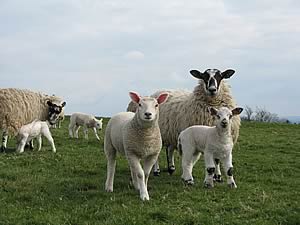| 2009-10-05
Improving conception rates by 10% through better management around tupping this season can easily result in 25 more lambs in a 300 ewe flock, boosting margins by more than £3.50 per ewe, reveal the latest ‘What If’ calculations from EBLEX, the industry body for beef and lamb levy-payers in England.
While increasing the lambing percentage may not be the best option for every flock given the increased incidence of triplets and quadruplets, lower birthweights and higher mortality levels it may generate, improving the rearing percentage should be the primary objective for all lamb producers. And the starting point for an improved rearing percentage has to be higher conception rates.
With a target 14% loss from scanning to sale, raising the average conception rate of a typical lowland flock from 1.85 to 1.95 will boost the rearing rate from 1.60 to 1.68 lambs per ewe, delivering an extra 8 lambs per 100 ewes and increasing gross margin per ewe by £3.60, the calculations show. What is more, even if total losses rise to 16% the flock will be better off to the tune of an extra 5 lambs per 100 ewes and £2.17 per ewe (Table).
Table: Increasing lowland flock conception rates with different levels of lamb mortality
|
Conception rate (lambs per ewe)
|
1.85
|
1.95
|
1.95
|
|
Mortality – conception to birth
|
6%
|
6%
|
7%
|
|
Lambing rate (lambs per ewe)
|
1.74
|
1.83
|
1.81
|
|
Mortality – birth to sale
|
8%
|
8%
|
9%
|
|
Rearing rate (lambs per ewe)
|
1.60
|
1.68
|
1.65
|
|
Extra lambs reared per 100 ewes
|
|
8
|
5
|
|
Extra gross margin per ewe
|
|
£3.63
|
£2.17
|
To ensure the best possible conception rates this tupping season, EBLEX recommends:
- Ensuring over 90% of ewes are in optimum body condition at tupping (3-3.5 for lowland flocks, 3.0 for upland flocks and 2.5 for hill flocks);
- Being particularly careful to avoid over-fat as much as over-thin ewes;
- Appreciating that younger ewes tend to have lower ovulation rates and suffer especially badly from being in less than ideal condition at tupping;
- Checking ram teeth, toes, testicles and tone (condition score 3.5-4.0) to make sure all tups are fully fit to breed;
- Flushing ewes and rams on a rising plane of nutrition for at least 3 weeks before the start of the breeding season;
- Keeping ewes close to rams or with a teaser (vasectomised) ram immediately prior to the breeding season;
- Maintaining the right ewe to ram ratio based on the type and fitness of the tups; and,
- Avoiding drastic changes to nutrition levels in first third of pregnancy so ewes maintain their bodyweight.
 Down Shep! Dog Handling Course for Shepherds Down Shep! Dog Handling Course for Shepherds
 NSA Sheep 2010 - Three Counties Show Ground NSA Sheep 2010 - Three Counties Show Ground
 Ritchey Autotagger a Hit with French Farmers Ritchey Autotagger a Hit with French Farmers
|


